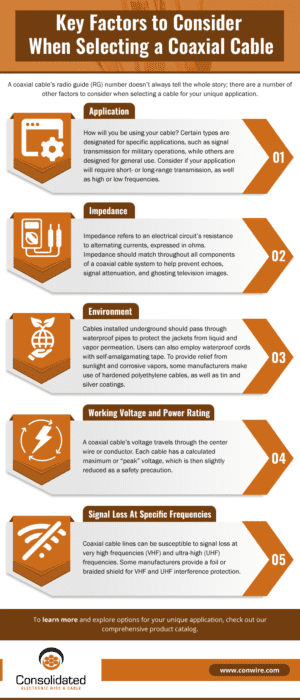RG6 vs. RG58 vs. RG59 vs. RG11 Coaxial Cables
Comments Off on RG6 vs. RG58 vs. RG59 vs. RG11 Coaxial CablesCoaxial cables, sometimes called coax cables, are indispensable for A/V and broadband signal transmission. Choosing the right type is very important for sending and receiving data across distances with minimal loss. The most common types of coaxial cable include RG6, RG58, RG59, and RG11. Here, we’ll look at how coax cable is constructed and used, as well as how the types differ.
A Primer on Coaxial Cables and RG Ratings
Coaxial cables are used to transmit and receive high-frequency signals, including radio, video, or broadband internet. A copper conductor wire at its core transmits signals. It is surrounded by a layer of dielectric insulation, which is covered with a grounded, braided metal shield, usually made from copper or aluminum. The dielectric material maintains a constant voltage differential between the conductor and the shield. A sturdy plastic jacket encloses the wire to protect it from damage and moisture.
Most types of coaxial cable carry what’s known as an RG, or radio guide, rating. The letters are followed by a number, such as 6, 58, 59, or 11, as we’ll explore here. These numbers are used to specify the correct type of cable for an installation and roughly indicate cable diameter; however, the number is not a specific measurement. Higher numbers are often larger than smaller ones. That said, some higher number cables may be thinner than lower numbers (e.g., RG59 is thinner than RG6).
Key Considerations for Selecting Industrial Coaxial Cables
The application determines the type of cable required to transmit signals with minimal loss. The primary things to consider about an application include:
- Signal Requirements. The size of the conductor determines the signal frequency, range, and strength for which the cable can be used.
- Environmental Conditions. This includes where the cable will be installed and if it needs protection from extreme temperatures, moisture, physical damage, vibration, or outdoor exposure.
- Handling. Different types of cable are more or less flexible, so consider whether the application will include frequent handling or flexing (during installation or regular use).
Additional considerations in facilities with unique operating requirements may include:
- Fire Protection. Some cables need flame-retardant materials for high-temperature applications, such as near industrial furnaces and ovens.
- Ingress Protection (IP). IP ratings ensure cables are protected from dust and moisture./li>
- Certifications and Standards. Industry-specific standards, such as UL or CE marks, are important for safety, performance, and legal compliance.
Coaxial Cable Comparison: RG6 vs RG58 vs RG59 vs RG11
While there are many types of coaxial cable available, four very common types are RG6, RG58, RG59, and RG11. They share similar materials and construction; however, they are generally not interchangeable and have some unique features for different applications.
RG6
This industry-standard cable can be used for indoor or outdoor applications. It is easily shaped and flexible. It is commonly used to carry A/V, HDTV, and broadband signals. This type of cable usually includes thicker dielectric material and an additional layer of aluminum shielding.
RG59
RG59 has a smaller diameter than RG6 cable and is best suited for lower-frequency, indoor applications that cover short distances. Like RG6 cable, it can be used for video, television, and CCTV signals. So are RG6 and RG59 interchangeable? They are not. The difference between RG6 and RG59 is the conductor inside a RG59 cable is smaller than the one in an RG6 cable, which means it does not provide the same signal quality, performs best at lower frequencies, and results in more signal loss than an RG6 cable. What’s more, RG59 cannot be used for broadband transmission.
RG58
Another type, RG58 cable, can be distinguished from RG59. It has a lower impedance of 50 Ohms compared to the standard 75 Ohms of almost all other coax cables. Lower impedance makes RG58 cable a good choice for signal boosting in low-frequency audio applications including radio and two-way radio. RG58 is also used for testing and measurement equipment in laboratory settings.
RG11
This type of coaxial cable is very thick and much less flexible than RG6 or RG59 cable. It is often used for outdoor and buried applications. Because the conductor is larger, it can be used for high-definition video signals and other high-frequency applications, and it can cover longer physical distances without compromising signal quality or transmission.
Contact Our Signal Transmission Experts for Standard & Custom Coax Cable Solutions
With an extensive selection of coaxial cables, electrical wires, and accessories, Consolidated Electronic Wire & Cable can provide a custom solution for your needs. Our custom capabilities include in-line engineering, assembly with molding, overmolding, cut-and-shrink tubing, tinning and soldering, ultrasonic welding, wire crimping and braiding, and testing services.
Learn more about our coaxial cable products or contact us for information about our capabilities and to discuss your application.
Coaxial Cable Guide: What Is It, Types, & Uses
Comments Off on Coaxial Cable Guide: What Is It, Types, & UsesA standard shielded cable has a simple design of spiral-wound or braided strands inside an insulative jacket. But what is a coax cable? Learn more about coaxial cables, how they work, and how to choose the appropriate option for your application.
 What Is a Coaxial Cable?
What Is a Coaxial Cable?
Cylindrical in shape, coaxial cables consist of four parts:
- External jacket
- Protective conducting shield
- Insulating dielectric material layer
- Internal metal conductor
“Coaxial” refers to the geometric axis the outer shield and inner conductor share. Unlike simple shielded cables transmitting low-frequency signals, coaxial cables offer superior transmission and reception capabilities, conducting alternating currents of radio frequency (RF). They’re a common choice for cable television, broadband Ethernet, and commercial radio transmissions.
How Do Coaxial Cables Work?
The central metal conductor transmits RF signals, with the surrounding layers facilitating. The dielectric insulator ensures that the spacing between the conductor and shield layer remains consistent for the full cable length while keeping their two signals from coming into contact and canceling out. The metal conducting shield safeguards signals against EMI and signal loss, creating a magnetic field with the conductor. Finally, the plastic cable jacket offers protection and insulation for the internal components.
While traditional shielded cables are used to transmit lower frequency signals, coaxial cables function as transmission lines, conducting alternating currents of radio frequency signals. With superior transmission and reception capabilities, coaxial cables are commonly used for broadband Ethernet, cable television, and commercial radio.
What Are The Different Types of Coaxial Cables?
Coaxial cables differ in design depending on their end use. Shorter cables often appear in household applications such as AV systems or personal Ethernet connections, while longer cables can connect entire radio and television networks or long-distance phones. Micro/mini cables are also frequently used in various consumer, military, aerospace, and medical devices.
Below are some of the most common coaxial cable types and the applications they support.
Hardline

Radiating
Also called “leaky cables,” radiating cables have a similar structure to hardline but with the addition of slots cut into the shield, tuned to specific wavelengths or radio frequencies. By allowing a pre-determined amount of “leakage” between the transmitter and the receiver, these cables can be implemented in locations where antennas are not feasible.
 Twinaxial
Twinaxial
Also known as “Twinax,” these cables share the same structure as coaxial cables but have two central conductors instead of one. They are used for high-speed, short-range signaling applications, such as network hardware with SFP+ interfaces.
Triaxial

Semi-Rigid
With a PTFE-supported dielectric and a shield made of a solid conductor instead of stranded wires, semi-rigid coaxial cables offer better dielectric properties for enhanced performance at high frequencies. Compared to rigid cables, however, semi-rigid lines are limited in size and frequency transmission.
Rigid Line
Rigid coaxial cables contain two copper tubes and a PTFE dielectric buffer supported at both ends of the cable as well as at various intervals throughout which prevents bends. Ranging from ⅞-inch to 8³/₁₆-inch diameters, rigid lines are much bigger than semi-rigid cables and have the power capacities to operate TV and FM frequencies with multi-channel transmission.
 RG-6
RG-6
Made with either a copper clad steel (CCS) or bare solid copper (BC) center, RG-6 cables are probably the most common coax cable, as they are used to relay cable television signals. Derived from the WWII military-specification “Radio Guide,” they are available in four different application-specific variations:
- Plain — For standard indoor/outdoor house wiring
- Flooded — Contains an additional water-blocking gel for underground conduits
- Messenger — Contains a steel wire to bear the tension of the aerial drop of a utility pole
- Plenum — Surrounded by a Teflon-based outer jacket to meet the fire codes of ventilation ducts
Coaxial Cable Connector Types
There are also an array of connector varieties available, with options including:
- Bayonet Neil-Concelman (BNC) connectors. Miniature to subminiature in size, these RF coaxial connectors allow you to quickly connect with and disconnect from television, radio, RF equipment, and testing instruments.
- Threaded Neil-Concelman (TNC) connectors. These miniature coaxial connectors operate at frequencies as high as 12 GHz. A weatherproof option, TNC connectors are applicable in creating RF/antenna and cellphone connections with minimized stability and leakage issues.
- Subminiature version B (SMB) connectors. Featuring an easy snap-on design on the coupling, SMB connectors are a tinier variety of SMA coaxial connectors. Ideal for semi-rigid cables with infrequent connections, they offer enhanced electrical performance, from DC to 4 GHz.
- 7/16 Deutsches Institut für Normung (DIN) connectors. These threaded RF coaxial connectors are compatible with cell network high-watt transmissions. 7/16 DIN connectors are also applicable for defense projects and antenna systems featuring several transmitters.
- QMA connectors. Offering quick-lock and -disconnect capabilities, QMA coaxial connectors are a type of SMA connector and share matching internal structuring.
- Micro coaxial (MCX) connectors. Compared to SMB varieties, MCX coaxial connectors have an OD of approximately one-third the size. Their operational frequency ranges from DC to 6 GHz, a good option for television tuner cards, wireless internet, digital cellular needs, GPS, and RF hardware.
- Radio Corporation of America (RCA) connectors. You’ll find these red, white, and yellow cords behind your television. Also called cinch connectors, RCA connectors are recognizable for their male connector end encompassed by a ring.
>> Learn More About the Different Types of Coaxial Connectors
Key Factors to Consider When Choosing a Coaxial Cable
A coaxial cable’s radio guide (RG) number doesn’t always tell the whole story; there are a number of other factors to consider when selecting a cable for your unique application.
- Application — How will you be using your cable? Certain types are designated for specific applications, such as signal transmission for military operations, while others are designed for general use. Consider if your application will require short- or long-range transmission, as well as high or low frequencies.
- Impedance — Impedance refers to an electrical circuit’s resistance to alternating currents, expressed in ohms. Impedance should match throughout all components of a coaxial cable system to help prevent echoes, signal attenuation, and ghosting television images.
- Environment — Cables installed underground should pass through waterproof pipes to protect the jackets from liquid and vapor permeation. Users can also employ waterproof cords with self-amalgamating tape. To provide relief from sunlight and corrosive vapors, some manufacturers make use of hardened polyethylene cables, as well as tin and silver coatings.
- Working voltage and power rating — A coaxial cable’s voltage travels through the center wire or conductor. Each cable has a calculated maximum or “peak” voltage, which is then slightly reduced as a safety precaution.
- Signal loss at specific frequencies — Coaxial cable lines can be susceptible to signal loss at very high frequencies (VHF) and ultra-high (UHF) frequencies. Some manufacturers provide a foil or braided shield for VHF and UHF interference protection.
Common Applications — What Are Coaxial Cables Used For?
Coax cables have myriad applications across industries. Common coaxial cable uses include:
- Transmitting data while preventing attenuation loss
- Amplifying cellphone signal for enhanced cell reception indoors
- Connecting high-speed broadband internet between a cable line and a modem
- Connecting televisions, home video equipment, and radios to antennas, satellites, and related receivers
- Providing television or internet service to individual offices, apartments, or residences from a primary cable line

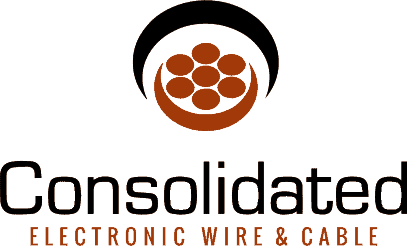


 () Quote Cart
() Quote Cart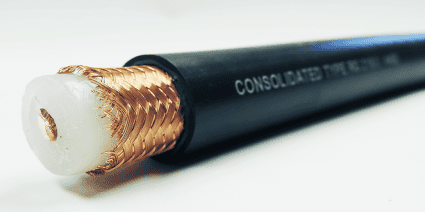


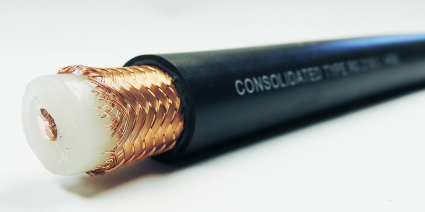 What Is a Coaxial Cable?
What Is a Coaxial Cable?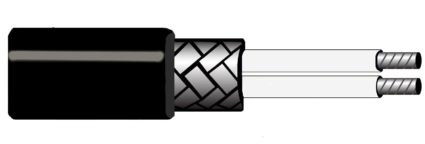 Twinaxial
Twinaxial
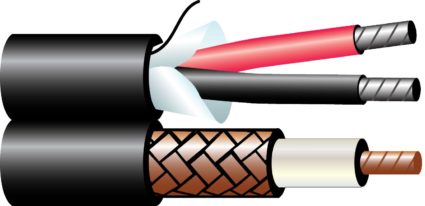 RG-6
RG-6